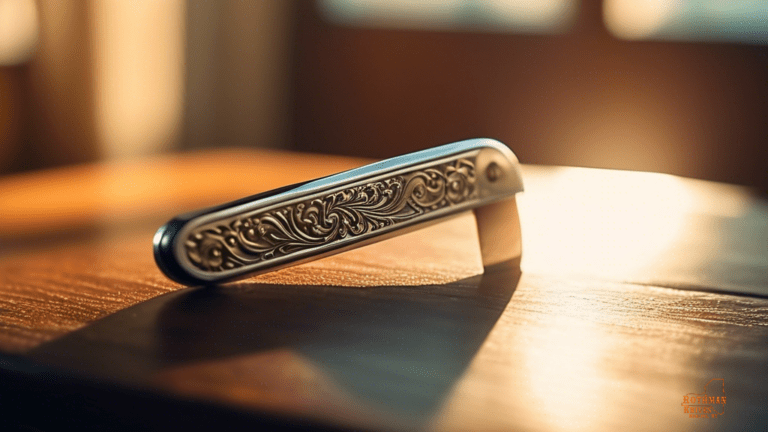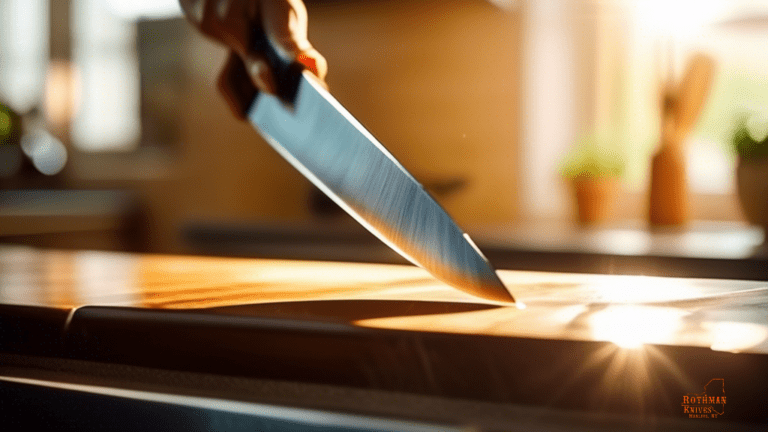Have you ever felt like sharpening your tools was a mysterious and daunting task?
Like trying to unravel a tangled ball of yarn with no end in sight? Well, fear not, because sharpening jigs are here to demystify the process and make it easier for beginners like you.
These handy tools are designed to help you achieve precise and consistent results, giving you the confidence to tackle any sharpening task that comes your way.
In this guide, we will take you on a journey through the world of sharpening jigs, explaining their purpose, different types available, and how to use them effectively.
By the end, you’ll be equipped with the knowledge and skills needed to sharpen your tools like a pro.
So, grab your sharpening jig and let’s dive in!
Key Takeaways
- Sharpening jigs are designed to help beginners achieve precise and consistent results.
- There are different types of sharpening jigs, such as honing guides, clip-on jigs, guide rails, and rotating jigs.
- The key steps in using a sharpening jig include securing the tool, setting the angle, and moving the tool across the sharpening surface.
- Maintenance tips for sharpening jigs include cleaning, lubricating, and storing them properly to ensure longevity and optimal performance.
Understanding the Purpose of Sharpening Jigs
Now, let’s dive into why sharpening jigs are essential for beginners who want to achieve precise and consistent sharpening results. As a beginner, you might feel overwhelmed by the idea of sharpening your tools by hand. That’s where sharpening jigs come in to make your life easier. These handy tools help you maintain the correct angle while sharpening, ensuring that you get a sharp edge every time.
By using a sharpening jig, you can feel confident in your sharpening skills and achieve professional-level results without the guesswork.
Imagine being part of a community where everyone shares the same goal of mastering the art of sharpening. Sharpening jigs provide a sense of belonging to this community by offering a common tool that unites beginners and experienced sharpeners alike.
With a sharpening jig, you can join this community with ease and learn from others who share your passion for sharp tools. Embrace the power of sharpening jigs and unlock your potential to sharpen like a pro.
Types of Sharpening Jigs
When you’re just starting out, you might be surprised by the variety of sharpening jigs available to help you get that perfect edge on your tools.
Here are four common types of sharpening jigs that you may come across:
- Honing Guide: This type of jig holds the blade at a specific angle while you sharpen it, ensuring a consistent edge across the entire blade.
- Clip-on Jig: These jigs easily clip onto the back of your chisel or blade, providing a guide for maintaining the correct sharpening angle.
- Guide Rails: Guide rails help you maintain a steady hand while sharpening, guiding your blade along a straight path for a precise edge.
- Rotating Jigs: These jigs allow you to rotate the blade or tool while sharpening, ensuring even wear on the sharpening stone and a consistent edge on your tool.
Exploring these different types of sharpening jigs can help you find the one that best suits your needs and preferences as you embark on your sharpening journey. Each type offers unique benefits and features that can make the sharpening process easier and more efficient for you.
How to Use a Sharpening Jig
Let’s dive into how to utilize a sharpening jig for your tools!
First, make sure you’ve selected the correct sharpening jig for the type of tool you’re sharpening.
Once you have your jig in hand, secure it to a stable surface and place your tool in the appropriate slot or clamp. This will ensure that your tool is held securely in place during the sharpening process.
Next, follow the instructions provided with your sharpening jig to set the correct angle for sharpening. This is crucial for achieving a sharp edge on your tool.
Once the angle is set, gently move the tool back and forth across the sharpening surface, making sure to maintain a consistent angle throughout.
Take your time and don’t rush the process – precision is key when using a sharpening jig.
With practice, you’ll become more comfortable and proficient at sharpening your tools with a sharpening jig, giving you the satisfaction of creating precise and sharp edges for your projects.
Tips for Maintaining Sharpening Jigs
To keep your sharpening tools in top condition, always remember to regularly clean and lubricate your sharpening jig for optimal performance.
After each use, take the time to wipe down the jig with a clean cloth to remove any debris or residue that may have accumulated. This simple step will help prevent any buildup that could affect the accuracy and effectiveness of your sharpening process.
Additionally, applying a small amount of lubricant to the moving parts of the jig will ensure smooth operation and longevity of the tool.
Remember, maintaining your sharpening jig is essential for consistent results and prolonged tool life.
Another helpful tip is to store your sharpening jig in a cool, dry place away from any moisture or extreme temperatures. This will prevent any rust or corrosion from forming on the jig, keeping it in prime condition for whenever you need to sharpen your tools.
By following these maintenance tips, you’ll be able to enjoy sharpening your tools with ease and precision, knowing that your sharpening jig is well taken care of.
Common Mistakes to Avoid when Using Sharpening Jigs
Avoid these common mistakes when using sharpening jigs to ensure a successful outcome.
First off, don’t rush the process. Sharpening your tools takes time and precision, so take a deep breath and focus on getting it right. Rushing through the sharpening process can lead to uneven edges or even damage to your tools. Remember, patience is key when it comes to sharpening jigs.
Another common mistake to avoid is applying too much pressure when sharpening. It’s important to let the sharpening jig do the work for you. Applying excessive pressure can result in an uneven edge or even cause the jig to slip, leading to potential injuries.
Trust the process and follow the instructions provided with your sharpening jig. By avoiding these common mistakes, you’ll be on your way to achieving perfectly sharpened tools in no time.
Frequently Asked Questions
Can sharpening jigs be used on any type of blade or tool, or are they only meant for specific types?
Sharpening jigs can be used on a variety of blades and tools, providing precision and ease for beginners. Whether it’s kitchen knives or woodworking chisels, these jigs offer a consistent sharpening experience for all types of blades.
Are there any safety precautions or gear that should be used when using a sharpening jig?
When using a sharpening jig, always wear safety goggles and gloves to protect yourself from any accidents. Remember, safety first! Keep your work area clean and organized for a smoother sharpening process.
How often should sharpening jigs be cleaned and maintained for optimal performance?
To keep your sharpening jig in top shape, clean and maintain it regularly. Aim for cleaning after every use and a more thorough maintenance session every few months. This will ensure optimal performance and longevity.
Can sharpening jigs be used on both straight-edged and serrated blades?
Yes, sharpening jigs can be used on both straight-edged and serrated blades. They provide a consistent angle for sharpening, ensuring a sharp edge on all types of blades. Keep your tools sharp and ready to use!
Are there any specific techniques or methods for sharpening jigs that can help achieve a sharper edge on blades?
To achieve a sharper edge on blades using sharpening jigs, try using a consistent angle, applying even pressure, and using the appropriate grit. These techniques will help you get the best results for your sharpening needs.
Last Updated: July 15, 2024
Verified and Approved by:

Mike Rothman
Founder of Rothman Knives
Like This Article?
Share with your friends
Table of Contents
Latest Articles
Keep Reading
-
From Tradition To Innovation: Exploring Historical Pocket Knives
Uncover the fascinating journey of historical pocket knives, from traditional roots to modern innovation. Dive into the craftsmanship and history behind these timeless tools today! Click to explore more.
-
Enhancing Your Stropping Technique With Stropping Compound
Learn how to enhance your sharpening technique with stropping compound and achieve razor-sharp blades effortlessly. Take your skills to the next level and improve your sharpening game today!
-
Mastering The Knife Sharpening Basics
Discover the secrets to mastering knife sharpening basics and elevate your culinary game! Our comprehensive guide will teach you everything you need to know to keep your blades razor-sharp. Say goodbye to dull knives and hello to precision cuts – click now to upgrade your kitchen skills!




